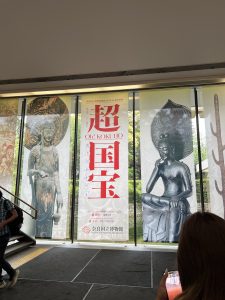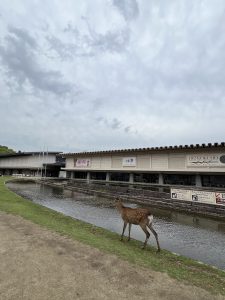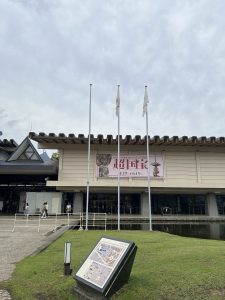行ってまいりました「超国宝展」(愛知県名古屋市千種区姫池通 骨董買取 古美術風光舎)
2025.05.20

そろそろ梅雨入りした地域もあるようですね。髪の毛もうまくまとまらないし、どことなくべとつくし…梅雨とはまだ言いませんが、先日からいろいろ湿気との闘いが始まっているような気がします。
でですね、予告しておりました
奈良国立博物館開館130年記念 特別展「超 国宝ー祈りのかがやきー」へ行って参りました!。ご覧の通りお天気は何とは雨は免れました。
本日は実際の画像がありませんので、検索等で実物を調べながらブログを読んでいただきますと幸いでございます。


それでは鹿に歓迎を受けながらの入館です。
さすがに東京国立博物館のような待ち時間ではなかったので、すぐに館内には入ることはできました。もちろん館内は撮影禁止でした。館内ですが出展数が143点ということもあり、ものすごくぎゅっと詰まった国宝展と言った印象でしょうか。
まず、入館すぐの目の前に法隆寺の国宝「観音菩薩立像(百済観音)」が展示されております。法隆寺での鑑賞ですともの凄く遠い位置から正面もしくは側面からしか見えないのですが、今回の展示はなんと観音の周りを距離も近くぐるりと鑑賞することができます。
百済観音の背面は、竹を模した柱に支えられた光背が特徴なのですが、その光背の支柱には竹の節が彫り込まれておりまるで竹の自然な様子を表現しているかのようです。支柱の基部には山岳文が描かれており、広大な山岳と対比することで、観音菩薩の広大無辺な姿を表現していると考えられいるようなのですが、その竹の光背のリアルを間近で見ることが出来ました。知らないと本当に竹?と思わせるほどの精巧な作り。また、あの百済観音のミステリアスな表情や緩やかな背の美しいラインをしっかりと見ることが出来る貴重な距離であります。
そして、今回は奈良での国宝展ということもあり、法隆寺をはじめ、東大寺、薬師寺、元興寺、唐招提寺、春日大社そして石上神宮などなど奈良でしかみれない仏像や調度品などが、すべてご紹介できませんが一同に鑑賞できる絶好のチャンスでもあります。
例えば、円成寺の国宝「大日如来坐像」。こちらは運慶の初期の作品でして、今回はじめて鑑賞ができたのですが完璧な美を追求した若かりし運慶の気迫が感じ取れるようでした。このように、普段あまりお目にかかれなかった国宝も。
そして予習しておりました元興寺の「八雷神面」。見てきましたが、裏から見ますとやはりお面。口のようになっているところが紐のようなもので開くようになっており、面のところどころにお姿やお顔があります。眼力バッキバキのちょっと夢に出てきそうなインパクトのあるご尊顔ですが、結構大きいお面ですのでどうやって使っていたのか気になりますね。
そんな中、時代を超えて素直にかわいい!と思える国宝もありまして。春日大社の国宝「金地螺鈿毛抜形太刀」なのですが、平安貴族が神様へ奉納した太刀なのですが、金を惜しみなく使いその中に螺鈿の猫と雀が追いかけっこしている螺鈿装飾が今でもしっかり確認することが出来ます。ペット好きの貴族の遊び心が時代を超えて、今でもその姿にかわいい!と思えます。
そして、展示室の最後に展示され大変注目を浴びていたのが、石上神宮の国宝「七支刀」。
一度訪れたことがあるのですが、とても厳粛な美しい神宮といった印象でしたが、場所も古墳群に近いということもあるのですが、なぜ「七支刀」がここに奉納されていたのか謎が深まるばかりなのですが。
古墳時代(四世紀)より石上神宮の神庫に「六叉鉾」として伝来されてきたものです。鉄製で身の左右に各3本の枝刃を段違いに造り出した特異な形をした剣でして、全長74.8㎝。下から約3分の1のところで折損していますが、剣身の棟には表裏合わせて60余字の銘文が金象嵌で表わされており、その解読が明治以降続けられ、現在では大体次の様に解釈されているようです。
(表面) 泰□四年(□□)月十六日丙午正陽造百練釦七支刀□辟百兵供供侯王□□□□作
(裏面) 先世以来未有此刀百済□世□奇生聖音故爲倭王旨造□□□世
冒頭の「泰□」の2字目は、現在僅かに禾偏(のぎへん)を思わせる線が残っているのみで、旁(つくり)にあたる所にはこの文字を探究した人がつけたと思われる傷痕があって、字は詳らかではありません。しかし、「泰和(たいわ)」として東晋(とうしん)の年号「太和」(西暦366~371)の音の仮借とみる説があり、それによるとこの七支刀は西暦369年に製作されたと考えられます。というか、古墳時代にすでに年号が存在していたことに驚きです…。
また、この七支刀は『日本書紀』に神功皇后摂政52年に百済から献上されたとみえる「七枝刀(ななつさやのたち)」にあたると推測されており、前述の推定に誤りがなければ、この七支刀の銘文は『日本書紀』の紀年を訂正し、その伝承を裏付けることになります。しかも、この銘文は我が国古代史上の絶対年代を明確にする最古の史料のようであります。
とまあ時間の許す限り滞在がしたのですが、もうちょっとゆっくりみたかった…もう一度行きたい。と思いながら閉館の17:00展覧会を後にしました。
なにせ会場は湧いておりますので、ぜひ予習をしてかれるとおススメいたします。また行きたい。
それではごきげんよう(スタッフY)
It seems that the rainy season has begun in some areas. My hair doesn’t manage to stay in place, it feels sticky somehow… I wouldn’t call it a rainy season yet, but I feel like I’ve been struggling with humidity since the other day.
So, here it is, as I had announced!
I went to the special exhibition “Super National Treasures: The Brightness of Prayer” in commemoration of the 130th anniversary of the Nara National Museum! As you can see, the weather was somehow spared from rain.
I don’t have any actual pictures today, so I would appreciate it if you could read this blog while looking up the actual exhibition through search engines, etc.
Now, let’s enter the museum while being welcomed by deer.
As expected, the wait was not as long as at the Tokyo National Museum, so we were able to enter the museum right away. Of course, photography was prohibited inside the museum. The museum has 143 exhibits, which gives the impression of a very tightly packed exhibition of national treasures.
First of all, the National Treasure of Horyuji Temple, “Standing Kannon Bosatsu (Hyakusai Kannon),” is displayed right in front of you. In the Horyuji exhibit, you can only see the statue from the front or the side from a great distance away, but this time, you can see all around the Kannon from a close distance.
The back of the Kannon features a halo supported by pillars that resemble bamboo, and the pillars are carved with bamboo joints, as if to represent the natural state of bamboo. The base of the pillar is decorated with a mountain pattern, which is thought to express the vastness of Kannon Bosatsu (Bodhisattva Guanyin) by contrasting it with the vastness of mountains. If you don’t know, it is really bamboo? If you don’t know, it is really bamboo? It is also a precious distance to be able to see the mysterious expression and the beautiful line of the gentle back of that Hyakusai Kannon firmly.
This exhibition of national treasures in Nara is also a great opportunity to view Buddhist statues and furnishings that can only be seen in Nara, including those of Horyuji Temple, Todaiji Temple, Yakushiji Temple, Gankoji Temple, Toshodaiji Temple, Kasuga Taisha Shrine, and Ishigami Jingu Shrine, to name a few.
For example, the National Treasure “Seated Dainichi Nyorai” at Enjoji Temple is an early work by Unkei. This is one of Unkei’s early works, which I was able to see for the first time, and I could feel the spirit of the young Unkei in his pursuit of perfect beauty. As you can see, there are some national treasures that we do not usually have the chance to see.
And then there was the “Hachiraijin Mask” at Genko-ji Temple, which I had studied in advance. I have seen it, but it is still a mask when seen from the back. The mouth-like part can be opened with a string, and there are figures and faces in various parts of the mask. The face has a strong impact, as if it might appear in a dream, but it is a rather large mask, so I wonder how it was used.
I wonder how they used to use them! There is a national treasure of Kasuga-taisha Shrine, “Kanade”. It is a sword dedicated to the gods by Heian aristocrats, and even today you can see mother-of-pearl inlay decorations of a cat and a sparrow chasing each other in the sword. The playful spirit of the pet-loving aristocrats has transcended the ages, and even today, the cat and sparrow are still cute! I think it is cute!
The last item on display in the exhibition room that attracted much attention was the National Treasure of Ishigami Jingu Shrine, the “Shichi-shi-tou” (Seven Swords).
I have visited the shrine once before and had the impression that it was a very solemn and beautiful shrine, but the location of the shrine is close to a group of ancient tombs, and the mystery of why the “Seven Swords” were dedicated here has only deepened.
It was brought to the Ishigami Shrine treasury as a “six-forked spear” from the Kofun period (4th century). It is a peculiarly shaped sword made of iron with three branch blades on each side of the body, each with a different step, and is 74.8 cm in length. The sword is 74.8 cm in length and is broken at about one-third from the bottom, but there are more than 60 characters inlaid in gold on the ridge of the sword body.
(Front) 16th day of the 4th month of the 4th year of the Tai □□ year □ 丙午 正陽造百練釦七支刀□辟百兵供侯王□□□□作
(Reverse side) Since the previous generation, this sword has not been made by the king of Japan.
The second character “泰□” at the beginning of the inscription has only a few lines that suggest a Jasmin (禾偏) radical, and there is a scar on the side of the radical that appears to have been made by a person who explored this character, so the character is not clear. However, there is a theory that the character “Taiwa” is a loan from the Eastern Jin Dynasty year “Taiwa” (A.D. 366-371), and according to this theory, this seven-syllable sword was made in A.D. 369. It is surprising that the year already existed in the Kofun period.
If the above-mentioned estimation is correct, the inscription on the seven-syllable sword corrects the chronology of the “Nihon Shoki” and confirms its tradition. Moreover, this inscription seems to be the oldest historical document that clarifies the absolute age of the sword in Japan’s ancient history.
I stayed as long as I could, but I wanted to spend more time at the museum…I want to go again. I left the exhibition at 17:00 when it closed.
I would recommend you to go to the exhibition after you have done some preparatory study. I would like to go again.
*****************
ご実家の整理やお片付けなどをされている方のご相談などが多くございます。
お片付けなどくれぐれもご無理のないようになさってくださいませ。
風光舎では古美術品や骨董品の他にも絵画や宝石、趣味のお品など様々なジャンルのものを買受しております。
お片付けをされていて、こういうものでもいいのかしらと迷われているものでも、どうぞお気軽にご相談下さいませ。
また風光舎は、出張買取も強化しております。ご近所はもちろん、愛知県内、岐阜県、三重県その他の県へも出張いたします。
まずは、お電話お待ちしております。
なお、毎月21日の持込鑑定会では無料鑑定・買取・持込など、ご予約なしで承っております。
ご近所の皆さま、ご遠方のみなさまも、お気軽にお越しくださいませ。
愛知県名古屋市千種区姫池通
骨董 買取【古美術 風光舎 名古屋店】
TEL052(734)8444
10:00-18:00 OPEN
#出張買取#骨董#古美術#骨董品#絵画#版画#茶道具#刀剣#彫刻

